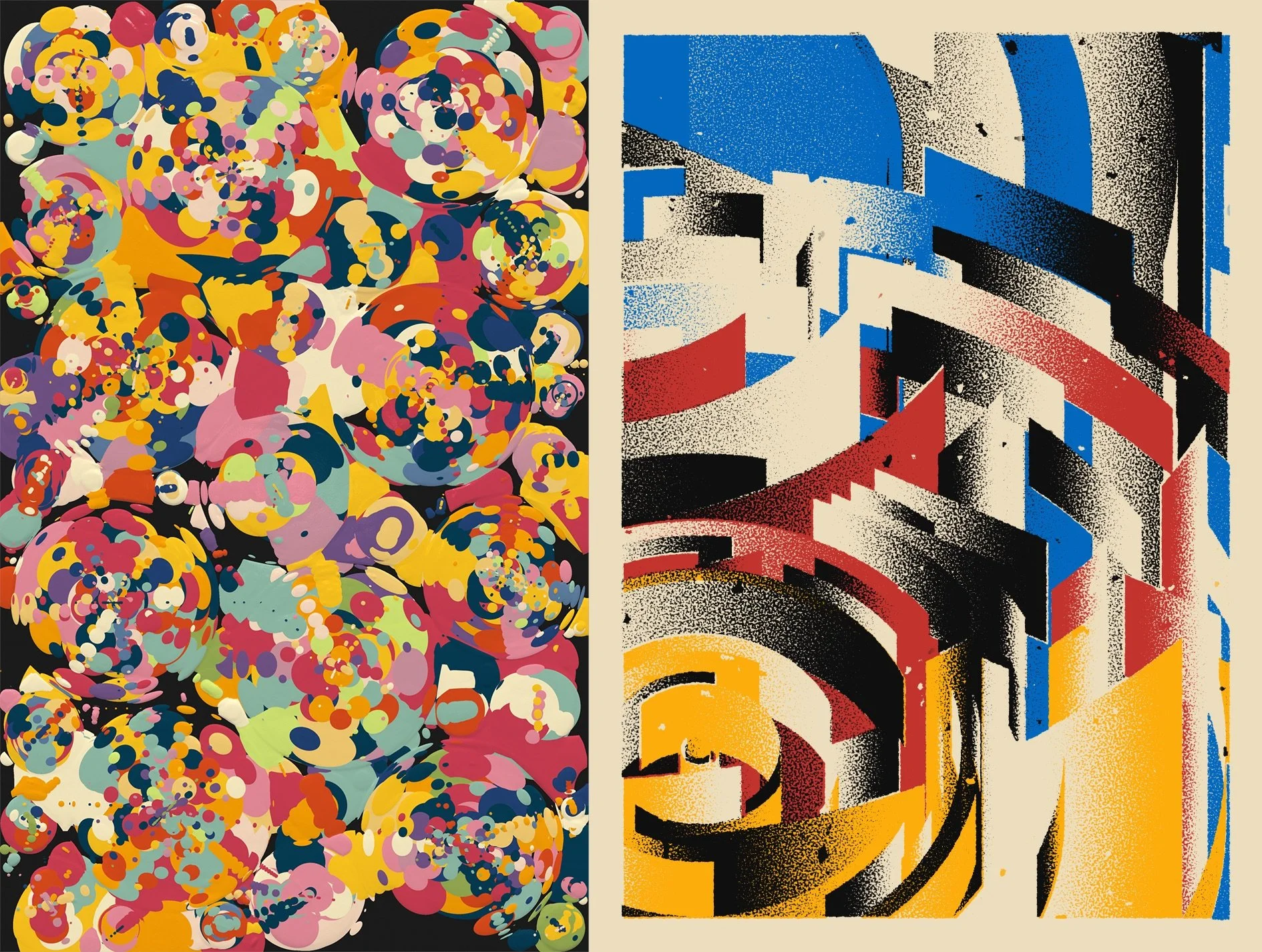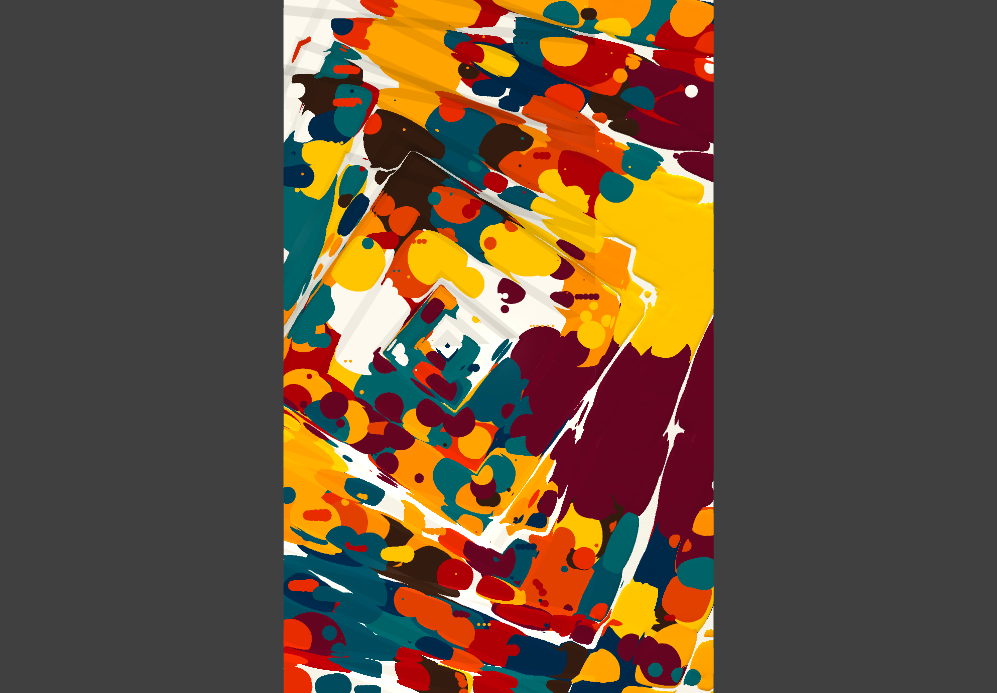Proscenium / Screens
Proscenium by Jimmy Griffeth (“remnynt”) is a collection of NFTs curated through a live rendering process done by the buyer each time they refresh the page. There are three stages to each piece in this collection, the animated live render, the digital output and then buyers have the option to purchase additional physical screen prints of the artwork, which is the intended medium for the full experience. The work begins as a 3D world which paint is dropped onto, with the bouncy mechanics of rubber. Once all the paint has been dropped on the canvas, the work collapses down to 2D. Throughout the rendering process, a user may click and drag, as well as use other controls outlined on the artist website, to move the piece around and see the dimension of the work as if it was a physical painting. See live render here
Proscenium live render May 16
The “proscenium”, or fourth wall, is the metaphorical plane in between the curtain and audience of a theater. Theaters with this design promote less communication between actors and audience than other designs, creating a sense of spectacle for the audience. This collection is doing a similar thing, representing the space between the digital and physical art worlds. The buyer can see the rendering, but not the underlying process behind it. It is also important to the artist that these works are not seen as reproduction of paintings. The act of watching the live render is meant to explore the possibility of software and digital art as an infinite medium, the works are not purely physical or digital.
The final stage to these pieces is the physical print. A buyer must own the NFT before requesting a physical print, which is screen printed by a small business designated by Griffeth. The first print is $300, and the price doubles with each additional print of the same token. Typically, when a physical object is linked to a NFT, the value and rarity of the physical object is increased. However, in this case, the physical cannot exist without the purchase of the digital version, so the increase might be even more than in other cases. Each piece in this collection has clear structure, with organic elements in the colors used. They can be organized into styles based on the original 3D landshape since that is the major factor influencing the output. There are nine different styles ranging from typical landscapes to sci-fi cityscapes. The colors of the pieces were also curated very carefully, with 17 different pallets containing colors that are true to life and bring brightness to the piece.
Screens #124 after live render
Screens by Thomas Lin Pedersen is also a collection of NFT artworks that are converted to screen prints if the buyer wishes. Pedersen’s generative system for this project mimics the screen printing process, going layer by layer, one color at a time. The layers are ordered from the lightest color to the darkest and the focus is on strong geometric shapes and gradients with a grainy rendering style.
There are many factors that influence the output for each piece. The five different actors determine the structure of the lines, the seven different scenes determine which actors are used and how many of each, the three different interactions determine how the intersections are treated, the four screen types determine the height of the screen. Pedersen was also very meticulous when choosing his 14 color palettes.
The colors and compositions of Screens were influenced by Bauhaus, Constructivism and pulp fiction sci-fi covers. Bauhaus style design is characterized by a focus on clean lines and lack of decoration often featuring simple geometric forms. Bauhaus also utilizes pops of primary color. Some traits of Constructivism include basic industrial geometric forms and colors. Pulp fiction sci-fi covers have bold colors, usually blues, greens, oranges and yellows. The influence of all of these elements can be seen throughout the collection.
It is important when looking at these two collections to notice the influence of screen printing on the artists. Both artists have availability for the work to be screen printed after it is purchased. Griffeth requires that the customer pays extra for the physical print, while Pedersen will print it for free. Screen printing is a printing technique that uses mesh to transfer ink onto a substrate, excluding specific areas that the ink cannot pass through because a blocking stencil is used. The design is transferred layer by layer, color by color using multiple screens for each color. Both collections have traits that show that the artists were influenced by the screen printing process and intended for the work to be complete with a physical print. Griffeth’s bold colors and limited color palettes are inspired by this process, as screen prints will produce vivid colors even on dark material. Similarly, the grainy texture in Pedersen’s collection is representative of the mesh screen used in screen printing, and the clear individual layers mimic the screen printing process.
Finally, these pieces can be analyzed by the fact that NFT art collectors are different from traditional collectors. Buying NFT art is an investment, on the art, over an investment, on the cryptocurrency. Typically, purchasing art through NFT is more about the investment than the art itself. By making these pieces available as a physical piece of art after the NFT is purchased, Griffeth and Pedersen are putting the emphasis back on their art rather than pure investment.
Sources:
Proscenium collection: https://www.artblocks.io/legacy/collections/curated/projects/0x99a9b7c1116f9ceeb1652de04d5969cce509b069/486?section=collection
Proscenium live render from artist website: https://vibes.art/proscenium/
What is a proscenium?: https://www.britannica.com/art/proscenium
Information on physical linking to nft: https://medium.com/javarevisited/from-digital-to-physical-how-physical-backed-nft-development-is-blurring-the-lines-of-art-21102bf30d85
Interview with remnynt on Proscenium: https://www.artblocks.io/legacy/info/spectrum/in-conversation-with-remnynt-on-proscenium
Screens collection: https://opensea.io/collection/screens-by-thomas-lin-pedersen
Screens collection(artist website): https://thomaslinpedersen.art/work/screens/
What is screen printing?: https://en.wikipedia.org/wiki/Screen_printing
Information on NFT collectors: https://www.artealdia.com/Reviews/NFTS-AND-METAVERSE-COLLECTORS-OR-INVESTORS-PART-II
Constructivist movement: https://www.theartstory.org/movement/constructivism/







